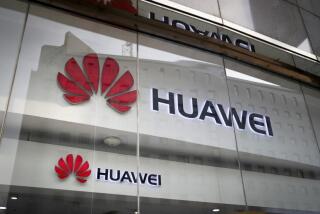IBM to Develop 64-Megabit Chip With Siemens : Technology: The joint venture is designed to loosen Japanese manufacturers’ domination of the market.
International Business Machines Corp. and Siemens AG, the West German electronics giant, on Wednesday announced a novel semiconductor development agreement squarely aimed at upsetting current Japanese domination of a key high-technology market.
The deal calls for the two companies to jointly design an advanced generation of computer memory chips that could be on the market as early as the mid-1990s. The specific product is a dynamic random access memory, or DRAM, chip capable of storing 64 million bits of data. The device would be 16 times more powerful than the most advanced memory chip currently available, a 4-megabit DRAM introduced commercially by IBM last year. DRAMs are the key memory storage units in computers.
Although the new technology is certain to boost the fortunes of both Siemens and IBM, an IBM spokesman admitted that the venture--the first joint chip development deal for IBM--has far more sweeping intentions: the disruption of Japanese control of nearly 80% of the DRAM market.
“This is part of our attempt to improve the overall balance of technology in the world,” the spokesman said of the agreement that has been in the making for the past year. “We see the global market as divided among European, U.S. and Asian companies, and we want to bolster the strength of U.S. and European” industries.
Worldwide sales of semiconductors reached about $50 billion last year, with memory chips accounting for about 25% of the total. U.S. DRAM producers, who held 59% of the market at the beginning of the 1980s, held 14% in 1988, according to a variety of industry research studies, while the share of Japanese manufacturers in the same period increased to 78% from 39%.
Analysts said the Siemens deal has the potential to reduce Japanese dominance of the DRAM market, in large part because it envisions introducing the new 64-megabit chip in the mid-1990s, several years ahead of currently available Japanese schedules. The companies said that sharing costs and technologies would aid the development process, although it is possible that the Japanese could accelerate their schedules as well. IBM is the world’s largest producer of semiconductors.
Further, analysts said, IBM’s recent aggressive deal making with other high-technology and semiconductor manufacturers offers the possibility that the 64-megabit chip design will be licensed to other U.S. DRAM makers, yet another move that would unseat the Japanese.
“This has the potential of upsetting the current balance of the DRAM market,” said Jerry Worchel, an analyst with In-Stat, a semiconductor market research firm in Scottsdale, Ariz. “This has global strategic competitiveness implications.”
Worchel said the Siemens deal also underscores the growing role that IBM is playing in trying to improve the overall competitive position of U.S. companies in the high-tech arena.
Other recent moves along these lines include the company’s first agreement to license its DRAM technology to an outside company when it allowed Micron Technology, a medium-sized semiconductor maker in Idaho, to use its design to make 4-megabit DRAMs late last year. IBM is also working on a highly advanced chip-making technique called X-ray lithography with Motorola Corp., one of the largest U.S. semiconductor manufacturers.
IBM was also a major force behind the recently failed attempt to create a DRAM-making cooperative called U.S. Memories and had agreed to license its 4-megabit DRAM technology to get the company off the ground. However, the venture failed to attract sufficient interest among computer makers who would have been its primary customers.
The Siemens deal calls for development of the 64-megabit chip to take place at IBM’s East Fishkill, N.Y., semiconductor center, with other work to be conducted at an IBM facility in Vermont and a Siemens plant in Munich. Each company will share equally in the development costs, which the companies declined to reveal. However, an IBM spokesman said the costs would ultimately run into the hundreds of millions of dollars.
Once the chip is designed, each company would manufacture it for its own use. IBM said it intends to use the chip in its own products and has no plans of selling it to other computer makers. However, a spokesman did not rule out the possibility that the firm would license the design to other manufacturers as it did with the 4-megabit chip.






